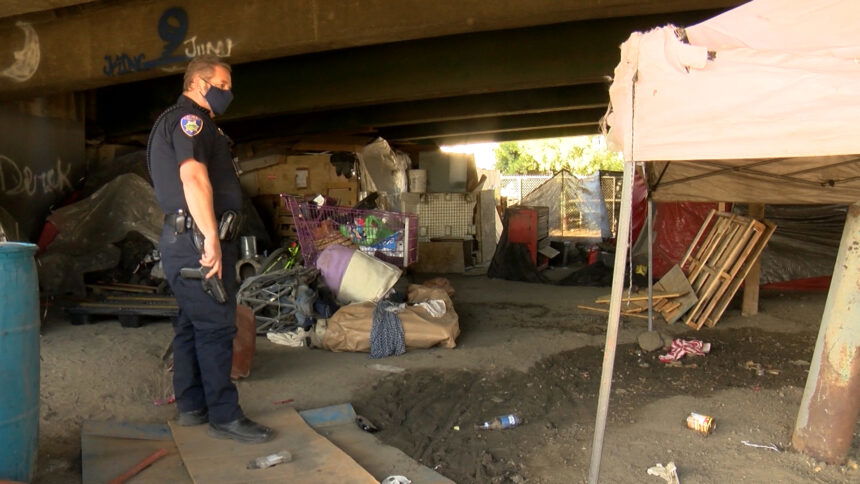SPECIAL REPORT: Salinas police balance blight and COVID-19 needs with homeless

SALINAS, Calif. (KION) COVID-19 has been a challenge for all of us this year, but what about those who have little means of protecting themselves?
When it comes to the homeless in Salinas, police are working daily to keep encampments sanitized and free of outbreaks. Even in the pandemic, there’s still one program going strong that is trying to get the homeless off the streets.
Over a hundred encampments dot the landscape of Carr Lake in Salinas, supported by over 100 homeless residents living in tents, make-shift shelters and sometimes under the ground.
“So the underground ones, it’s usually five or six that are just constantly being re-dug after we come back and fill them in,” said Officer Gabriel Carvey, who is on the Salinas Police's Homeless Outreach Team.
Carr Lake — off East Laurel Drive — is one of five major homeless encampments in the city. Salinas police did a couple cleanups here trying to thin out some of the garbage that collects.
Officer Carvey says the hardest part of the job is balancing the humanitarian empathy for people without homes with the blight and ecological issues that arise with encampments.
All this garbage sometimes gets washed out to the bay during the rainy season. Theft is also an issue, especially with a nearby golf course.
“So this should all be just a natural habitat, but it just gets destroyed and leveled and fires built and encampments, and of course, people are using the restroom everywhere," said Officer Carvey.
Monterey County health officials are directing law enforcement to maintain sanitation during COVID-19 among the homeless through cleanups. But Salinas is no longer enforcing the ban on overnight camping in city park — even if police conduct a clean up, the homeless can move back immediately after. It’s a move that’s brought back tents to Sherwood Park.
It’s here members of the Downtown Streets Team work —a non-profit volunteer work-experience program that provides men and women experiencing homelessness with the soft skills needed to re-enter the workforce.
Downtown Sreets has been operating for over a year in Salinas, mainly in Downtown, Chinatown and Sherwood Park. There are 27 team members total right now who volunteer four hours a day, including Isaac, who says the program has been life-changing.
“I’m a morning person, not a night person. I like to get up in the morning and I look forward to it in the morning, so it makes me happy,” said Isaac.
“With this COVID, it’s kind of interesting to see how many people we’ve seen that were employed before because of the pandemic now are out in the streets with no support system," said Maria Cambron, the project manager for the Salinas Downtown Streets Team.
Even with COVID-19, the program is doing very well. There have already been three “graduates” from homelessness, meaning those individuals are now fully housed, fully employed and no longer need the support.
“We’re also looking for expansions in different areas. And with the support of people, with the funds and the financial support of everybody else, we’re able to do that and keep supporting our team members," said Cambron.
The 2019 Monterey County Homeless Point-in-Time Census and Survey lists over 2,400 people in the county are homeless. Over 1,100 of them live in Salinas — 976 are considered “unsheltered.” But police say those are only estimates.
There’s no solid number of how many homeless have been infected with coronavirus. Their living situation and difficulty getting personal protective equipment make homeless an at-risk population, even as groups like Clinica de Salud try and provide testing.
What’s worse, COVID-19 has made it harder for addiction treatment centers to take in more new clients. But for people like Officer Carvey — who says he’s grown more empathetic through this job — seeing the little success stories gives him the most satisfaction.
“It makes you more aware of the human condition. These are somebody’s mothers, somebody’s brothers, sisters, you know, all those things. Instead of recognizing it as this general homeless problem, but seeing individuals and trying to help individuals out of their current situation, has definitely created a different dynamic in how I approach things,” said Officer Carvey.
